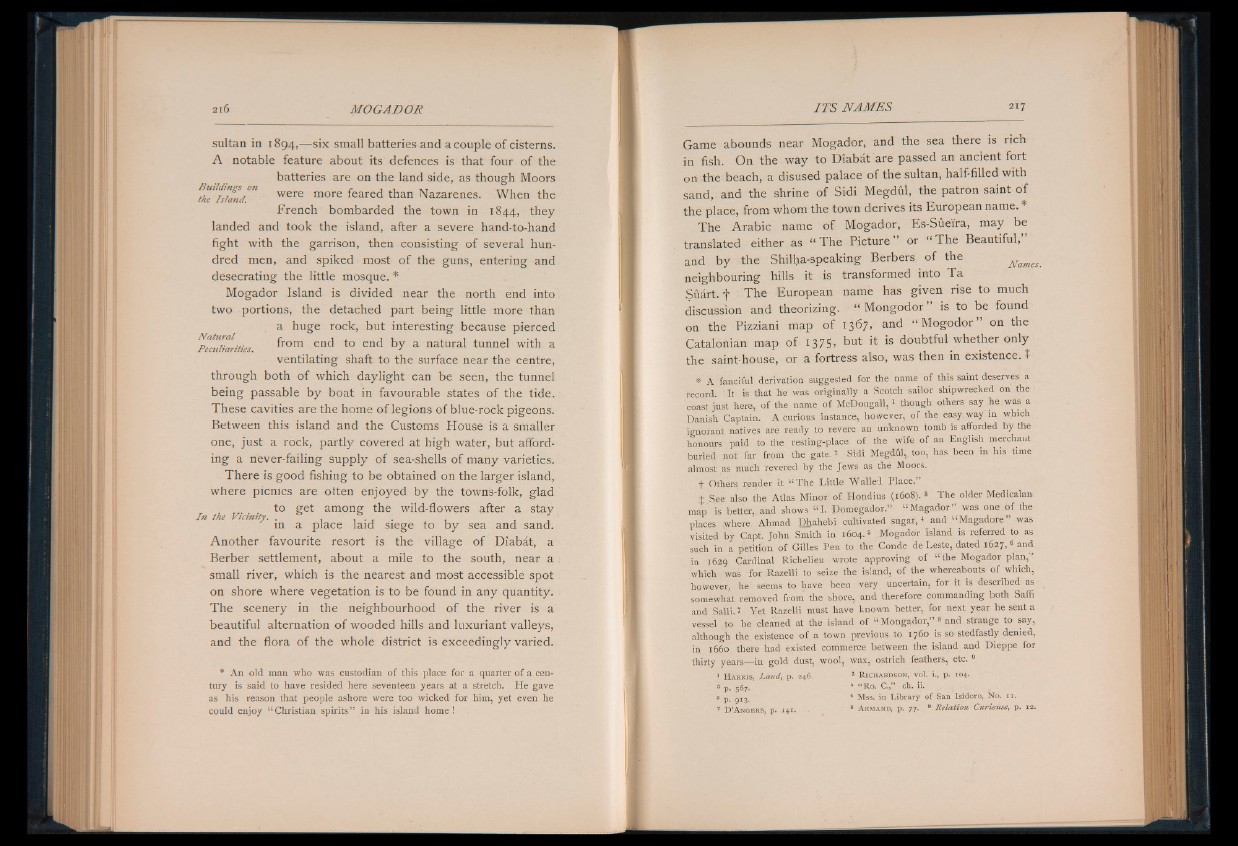
sultan in 1894,— six small batteries and a couple of cisterns.
A notable feature about its defences is that four of the
batteries are on the land side, as though Moors
^ ,lfs h n /n were more feared than Nazarenes. When the
French bombarded the town in 1844, they
landed and took the island, after a severe hand-to-hand
fight with the garrison, then consisting of several hundred
men, and spiked most of the guns, entering and
desecrating the little mosque. *
Mogador Island is divided near the north end into
two portions, the detached part being little more than
a huge rock, but interesting because pierced
Peculiarities from end to end by a natural tunnel with a
ventilating shaft to the surface near the centre,
through both of which daylight can be seen, the tunnel
being passable by boat in favourable states of the tide.
These cavities are the home of legions of blue-rock pigeons.
Between this island and the Customs House is a smaller
one, just a rock, partly covered at high water, but affording
a never-failing supply of sea-shells of many varieties.
There is good fishing to be obtained on the larger island,
where picnics are often enjoyed by the towns-folk, glad
to get among the wild-flowers after a stay
In the Vicinity. , • , . , ,
in a place laid siege to by sea and sand.
Another favourite resort is the village of Diabat, a
Berber settlement, about a mile to the south, near a
small river, which is the nearest and most accessible spot
on shore where vegetation is to be found in any quantity.
The scenery in the neighbourhood of the river is a
beautiful alternation of wooded hills and luxuriant valleys,
and the flora o f the whole district is exceedingly varied.
* An old man who was custodian of this place for a quarter of a century
is said to have resided here seventeen years at a stretch. He gave
as his reason that people ashore were too wicked for him, yet even he
could enjoy “ Christian spirits” in his island home !
Game abounds near Mogador, and the sea there is rich
in fish. On the way to Diabat are passed an ancient fort
on the beach, a disused palace of the sultan, half-filled with
sand, and the shrine of Sidi Megdul, the patron saint of
the place, from whom the town derives its European name.
The Arabic name of Mogador, Es-Sue'fra, may be
translated either as “ The Picture ’ or “ The Beautiful,
and by the Shilha-speaking Berbers of the
neighbouring hills it is transformed into Ta
Suart. f The European name has given rise to much
discussion and theorizing. “ Mongodor” is to be found
on the Pizziani map of 1367, and “ Mogodor” on the
Catalonian map of 1375, but it is doubtful whether only
the saint-house, or a fortress also, was then in existence, t
* A fanciful derivation suggested for the'name of this saint deserves a
record. It is that he was originally a Scotch sailor shipwrecked on the
coast just here, of the name of McDougall, 1 though others say he was a
Danish Captain. A curious instance, however, of the easy, way in which
ignorant natives are ready to revere an unknown tomb is afforded by the
honours paid to the resting-place of the wife of an English merchant
buried not far from the gate. 2 Sidi Megdul,. too, has been in his time
almost as much revered by the Jews as the Moors,
j- Others render it “ The Little Walled Place.”
4 See also the Atlas Minor of Hondius (1608). 3 The older Medicalan
map is better, and shows “ I. Domegador.” “ Magador” was one of the
places .where Ahmad Dhahebi cultivated sugar, * and “ Magadore” was
visited by Capt. John Smith in 1604.5 Mogador Island is referred to as
such in a petition of Gilles Pen to the Conde de Leste, dated 1627, 3 and
in 1629 Cardinal Richelieu wrote approving of “ the Mogador plan,”
which was for Razelli to seize the island, of the whereabouts of which,
however, he seems to have been very uncertain, for it is described as •
somewhat removed from the shore, and therefore commanding both Saffi
and S a l l i .Y e t Razelli must have known better, for next year he sent a
vessel to be cleaned at the island of “ Mongador,” 8 and strange to say,
although the existence of a town previous to 1760 is so stedfastly denied,
in 1660 there had existed commerce betWeen the island and Dieppe for
thirty years— in gold dust, wool, wax, ostrich feathers, etc. 3
1 H a r r i s , Land,, p. 246. 2 R i c h a r d s o n , vol.' i., p. 104.
3 567. ^ ^ Ro# C»j ch. ii.
5 p; 913. 6 Mss. in Library of San Isidoro, No. n .
7 D’A n g e r s , p. 141. 8 A r m a n d , p. 77. 9. Relation Curieitse> p. 12.